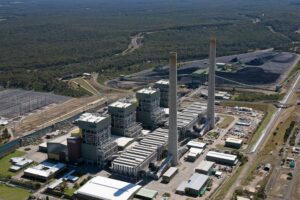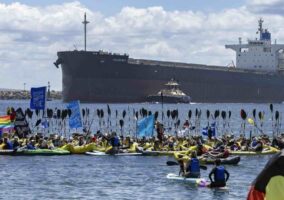The NSW government asked consumers to refrain from unnecessary electricity use on Wednesday afternoon, and the Australian Energy Market Operator put out a call for emergency reserves, as the absence of five big coal and gas units put pressure on the grid in the middle of this week’s heatwave.
AEMO has identified the biggest challenge for the grid will be ensuring enough supply is available to meet consumer demands between 3pm and 8pm, particularly as the output of rooftop PV declines with the setting of the sun.
The state’s rapidly growing capacity of rooftop solar installations ensured there was ample supply – and relatively low prices – in the middle of the day – but the absence of more than 3 gigawatts (GW) of coal and gas fired generation due to planned and unplanned outages meant that more backup had to be sought for the evening peak.
The AEMO lack of reserve (LOR) market forecasts oscillated on Wednesday between an LOR2 and the more serious LOR3, which could result in load shedding if it materialises. AEMO says it secured capacity under its emergency reserve trader mechanism, which can include switching on diesel of switching off unneeded industrial loads.
“This situation is a result of heatwave conditions combined with the unavailability of major power stations,” AEMO said in a statement issued just after 3pm (AEDT).
State premier Chris Minns called a press conference in the middle of the day to ask consumers not to use their dishwashers, washing machines or other nonessential appliances between 3pm and 8pm.
“You’ll be helping the grid,” Minns said. “We’re hoping that these measures reduce the amount of demand on the energy system over that crucial 3pm to 8pm period, and as a result, won’t lead to load shedding or blackouts.”
Earlier, state energy minister Penny Sharpe said government agencies and government owned buildings had been directed to reduce demand, by adjusting air-con temperature settings, closing blinds, turning off non-essential lighting and turning off equipment when not in use.
“Every small step to reduce demand makes a difference,” Sharpe said. But she emphasised that energy could be consumed as normal prior to 3pm thanks to the impact of rooftop solar. “Energy should be used as normal prior to 3pm when rooftop solar panels are powering much of the state,” she said.
Shortly after 3pm, the wholesale electricity price in NSW surged well above $1,000/MWh as generators took advantage of the scarcity of supply and their market power. They are likely to hit or get near to the market cap as the rooftop solar output from their customers (who they care deeply about) starts to peter out.
The NSW state government recently signed an underwriting deal worth up to $450 million with Origin Energy to keep its Eraring coal fired power station – the country’s largest – open for another two years till late 2027.
However, one of its units is offline, and its delayed return until the end of the week has been cited as one of the critical factors in putting supplies under stress with high temperatures on Wednesday and Thursday.
The other major fossil fuel generation units offline are two at the Bayswater coal fired generator, one at the Vales Point coal fired generator, and the Tallawarra A combined cycle gas generator.
AEMO is confident it can keep the lights on and avoid any load shedding, but when the supply is tight it means it has few resources to turn to if another big fossil fuel generator buckles unexpectedly in the heat. Or if a transmission line trips.
AEMO has constantly stated that the biggest threat to supplies is from unexpected trips from ageing fossil fuel generators.
But the situation in NSW again highlights – as does the newly announced South Australian move to get two diesel generators out of mothballs – that Australia has failed to focus enough on energy efficiency and demand management, which would be cheaper and more manageable alternatives in such situations.
One of the reasons that demand response mechanisms have been so limited in Australia is that the incumbent utilities argued strongly against them, coming up with arguments such as the inability to hedge, and preferred instead to build new generators that are expensive to run.
“They wouldn’t be scrabbling now If they were properly enabling consumers to manage their own demand, and unleashing development and connection of renewables, including through orderly closure of coal plants,” said Stephanie Bashir, from Nexa Advisory.
“The solution to accelerating the clean energy transition sits squarely with the NSW Government. The Minns government is yet to publish its energy plan for NSW. Projects already in the pipeline are clogged inside it. And it’s clear that extending Eraring is not even a good bandaid.”
The situation in NSW will also be helped by a number of new big battery projects, but most of these are not yet fully commissioned or are still under construction. The state’s operating big batteries include the 150 MW and 300 MWh Riverina and Darlington batteries, the remote Broken Hill battery and the Wallgrove battery in western Sydney.
Federal energy minister told parliament that AEMO had advised him that enough capacity had been obtained to manage supply – apart from another unexpected outage – and noted that battery storage would play an important role in the evening peak. It was not the fault of renewables, as the Coalition had claimed, he said.
The current fleet of batteries in NSW are relatively small, but that will change soon with the addition of the 850 MW, 1680 MWh Waratah Super battery.
Other big batteries underconstruction include the 500 MW, 1,000 MWh Liddell battery, the 700 MW, 2,800 MWh Eraring battery and the 250 MW, 500 MWh Williamsdale battery, along with three eight-hour batteries that will also be underwritten by the NSW government.
Those eight hour battery projects include a 275 MW, 2,200 MWh facility at Myrtle Creek in northern NSW, the 49 MW, 392 MWh Goulburn River facility, and the 50 MW, 400 MWh Limondale battery.
The 100 MW, 200 MWh Capital battery is also going through commissioning, with other big batteries are under construction at Koorangie, Quorn Park, Smithfield, Orana, and New England. And this week the state government approved a new 500 MW, 2,000 MWh big battery at Mt Piper, next to the existing coal fired generator.











Leave a Reply